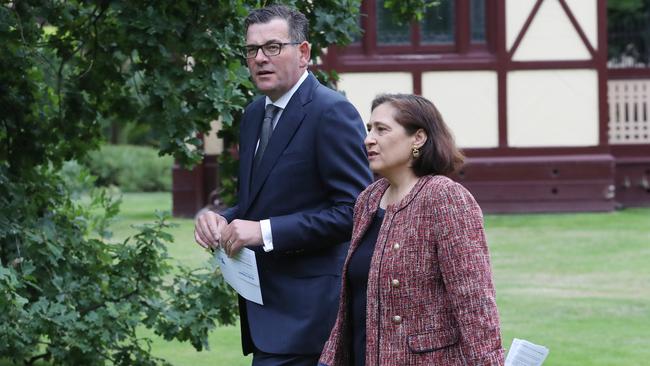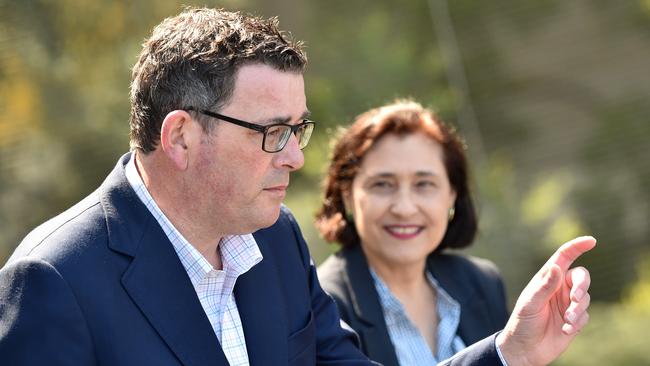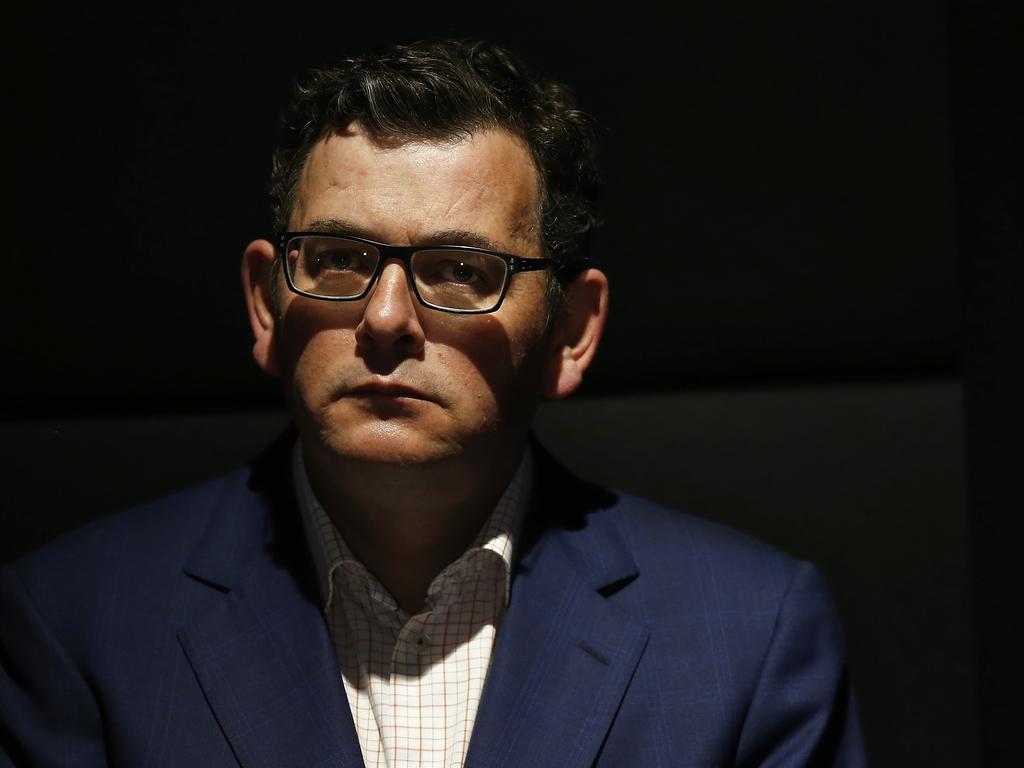
It was early 2014 and all hell was breaking loose around the then opposition leader over whether he had listened to a reporter’s dictaphone “found” by a member of his staff.
Police were investigating and the media was piling on.
Yes, Andrews conceded, a staffer had come into possession of The Age reporter’s device after it was misplaced at a Victorian ALP conference.
No, Andrews insisted, he hadn’t personally listened to the multiple recorded interviews, including one with former Liberal premier Ted Baillieu in which he sprayed Liberals.
As to how the Baillieu interview found its way from the Labor leader’s office to “friendly” Liberals who, in turn, leaked it to the world, was anyone’s guess.
The dictaphone scandal was the first serious integrity crisis for Andrews, and it was also the first time he deployed his “deny, sacrifice and move on” political survival strategy.
By today’s polished (brazen) standards, Andrews’ performance was shaky. Some political observers even described it as sweaty.
But ultimately denying any personal culpability and throwing a loyal staff member under the bus worked. The short attention span of the media and public, an incompetent Liberal government and the community’s comfort with the Labor brand combined to do the rest. By year’s end, Daniel Andrews had stormed to a historic election victory and was Premier of Victoria.
Fast forward nine years and it’s not surprising Andrews has mastered the “deny, sacrifice and move on” defence. He’s had plenty of practice. A full list of his administration’s scandals could fill this entire edition of The Weekend Australian.
The “red shirts” rort that saw Labor cheat $400,000 from taxpayers to help it win the 2014 election should have been enough to end his political career. But it didn’t. Andrews denied being aware of the rip-off and the ALP repaid the money.
Three, probably four, secret appearances before IBAC as the integrity agency grilled him in private during anti-corruption investigations were brushed aside, with Andrews denying one damning report was in fact damning. Nup, Operation Daintree’s investigation into millions of taxpayer dollars being funnelled to a union amounted to nothing more than an “educational report”, according to the Premier.
Most audacious of all was Andrews’ great escape from responsibility for his bungled response to Covid-19, most critically his government’s hotel quarantine mistakes that triggered the second wave that killed 800 Victorians and locked Melbourne down for 112 days.
No one, including Andrews, could recall whose idea it was to hire the private security guards responsible for the virus leaks. In the end, Andrews’ health minister and chief bureaucrat were sacrificed as a result of the hotel inquiry. You get a sense that Andrews didn’t lose a second of sleep after he threw Jenny Mikakos under that bus, washed his hands, turned around and got on with business without even looking over his shoulder.
Andrews, of course, didn’t lose his job. No, he told Victorians resigning would be “cutting and running” and it was his responsibility to hang around and fix the mess.
This week, Daniel Andrews has been engulfed by another integrity firestorm – this one lit by revelations on the front page of The Australian that an ALP branch associated with his factional ally and senior minister Lily D’Ambrosio forged the signatures of dead men as part of a branch-stacking enterprise.
So far, Andrews has only had to pull two of the three triggers, deny and move on. He doesn’t appear to show any sign, at least yet, that he thinks D’Ambrosio will have to be sacrificed.
As the scandal unfolded, Andrews stared down the barrel of the cameras and denied there were parallels between this new branch-stacking scandal in his own Socialist Left faction and similar controversies that forced the resignations of three right-wing Labor ministers.
In Victorian politics, the most effective hits are always inside jobs. And in the case of this one, the fact someone in Labor took the shot at the Premier’s old-guard minister is as much the story as the actual substance of the branch-stacking revelations that saw at least two dead men re-signed as Labor Party members in a branch associated with D’Ambrosio. It reflects a realignment under way in the Andrews government caucus and within the broader ALP as MPs and factional powerbrokers prepare for life after Andrews.
The consensus among Labor politicians and party figures is that the Premier will walk in the middle of 2024, and retire a triple election-winning Labor hero.
“When you talk to MPs, the conversation isn’t so much about if Daniel will go because most already believe that is a given. Most of us believe he will be gone by the middle of next year. So the talk is more about life in a Labor world without Daniel,” one Labor veteran observed.
It’s from this jungle of political volatility and ambition that the shot was taken at D’Ambrosio, an audacious hit on one of the Premier’s key confidantes. As another Labor figure noted, if those responsible thought Andrews was hanging around, it’s unlikely the trigger would have been pulled.

The other significant aspect is there are suspects on both the Left and Right of Labor.
It seems everyone has something to gain from damaging D’Ambrosio ahead of Andrews’ expected retirement.
“We’ve all known for years that Lily was vulnerable around branch stacking, but it’s only now that someone has chosen to act on that vulnerability. And that says so much,” a Labor figure said.
D’Ambrosio had been perceived by some in the Left to be positioning herself for a senior leadership role post-Andrews, and damaging her would help deliver the double act of Deputy Premier Jacinta Allan as premier and Health Minister Mary-Anne Thomas as deputy premier that is preferred by sections of the Left.
Under this scenario, ambitious right-wing Transport Minister Ben Carroll would become treasurer. (Few expect the current Treasurer, Tim Pallas, to stick around much past next year. In fact, some in Labor believe he has already checked out).
But the Right had plenty to gain from whacking D’Ambrosio too, hoping that it might unsettle the Left more broadly and allow Carroll to present as an unlikely challenger for the top job, or deputy spot.
Victorians should expect to see more Labor-on-Labor violence both in the caucus and the party over the coming 12 months as preparations for a leadership transition gain momentum.
This all comes as the Andrews government is trying to navigate its way through its choppiest waters in a decade. Years of reckless spending and pandemic borrowings have shredded the state budget, with debt spiralling towards $200bn, forcing job cuts, gutting basic services and leading directly to unpopular decisions like axing the 2026 Commonwealth Games.
But political ambition is a potent force and despite the financial mess Andrews is likely to leave behind that could cast his successor as a latter-day Joan Kirner, there is no shortage of would-be leaders ready to do whatever it takes in the coming year to improve their chances of seizing power, or at least seizing more influence, in the post-Dan world.








It was the moment Daniel Andrews probably realised the laws of political gravity didn’t necessarily apply to him. At least not with sufficient force to pull him down.